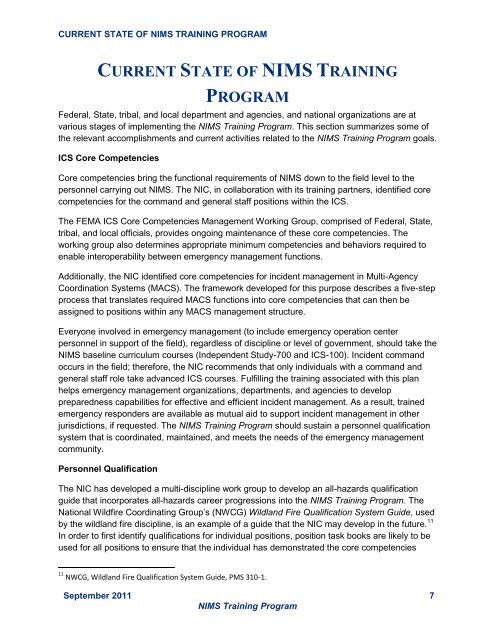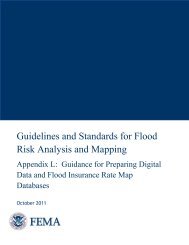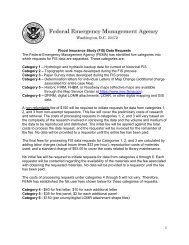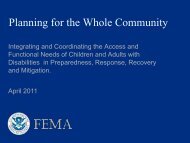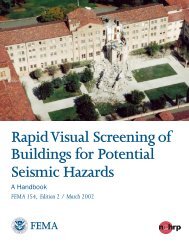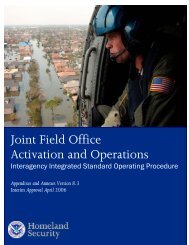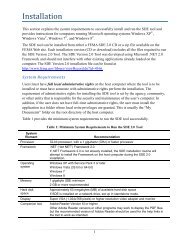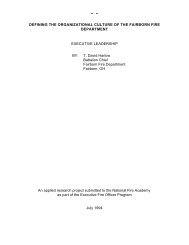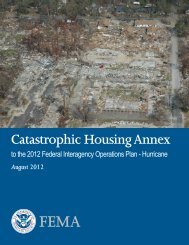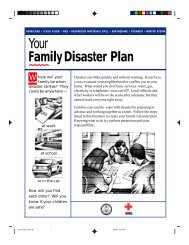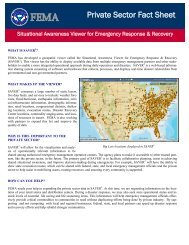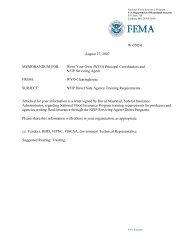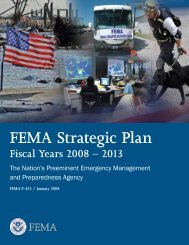NIMS Training Program - Federal Emergency Management Agency
NIMS Training Program - Federal Emergency Management Agency
NIMS Training Program - Federal Emergency Management Agency
You also want an ePaper? Increase the reach of your titles
YUMPU automatically turns print PDFs into web optimized ePapers that Google loves.
CURRENT STATE OF <strong>NIMS</strong> TRAINING PROGRAM<br />
CURRENT STATE OF <strong>NIMS</strong> TRAINING<br />
PROGRAM<br />
<strong>Federal</strong>, State, tribal, and local department and agencies, and national organizations are at<br />
various stages of implementing the <strong>NIMS</strong> <strong>Training</strong> <strong>Program</strong>. This section summarizes some of<br />
the relevant accomplishments and current activities related to the <strong>NIMS</strong> <strong>Training</strong> <strong>Program</strong> goals.<br />
ICS Core Competencies<br />
Core competencies bring the functional requirements of <strong>NIMS</strong> down to the field level to the<br />
personnel carrying out <strong>NIMS</strong>. The NIC, in collaboration with its training partners, identified core<br />
competencies for the command and general staff positions within the ICS.<br />
The FEMA ICS Core Competencies <strong>Management</strong> Working Group, comprised of <strong>Federal</strong>, State,<br />
tribal, and local officials, provides ongoing maintenance of these core competencies. The<br />
working group also determines appropriate minimum competencies and behaviors required to<br />
enable interoperability between emergency management functions.<br />
Additionally, the NIC identified core competencies for incident management in Multi-<strong>Agency</strong><br />
Coordination Systems (MACS). The framework developed for this purpose describes a five-step<br />
process that translates required MACS functions into core competencies that can then be<br />
assigned to positions within any MACS management structure.<br />
Everyone involved in emergency management (to include emergency operation center<br />
personnel in support of the field), regardless of discipline or level of government, should take the<br />
<strong>NIMS</strong> baseline curriculum courses (Independent Study-700 and ICS-100). Incident command<br />
occurs in the field; therefore, the NIC recommends that only individuals with a command and<br />
general staff role take advanced ICS courses. Fulfilling the training associated with this plan<br />
helps emergency management organizations, departments, and agencies to develop<br />
preparedness capabilities for effective and efficient incident management. As a result, trained<br />
emergency responders are available as mutual aid to support incident management in other<br />
jurisdictions, if requested. The <strong>NIMS</strong> <strong>Training</strong> <strong>Program</strong> should sustain a personnel qualification<br />
system that is coordinated, maintained, and meets the needs of the emergency management<br />
community.<br />
Personnel Qualification<br />
The NIC has developed a multi-discipline work group to develop an all-hazards qualification<br />
guide that incorporates all-hazards career progressions into the <strong>NIMS</strong> <strong>Training</strong> <strong>Program</strong>. The<br />
National Wildfire Coordinating Group’s (NWCG) Wildland Fire Qualification System Guide, used<br />
by the wildland fire discipline, is an example of a guide that the NIC may develop in the future. 11<br />
In order to first identify qualifications for individual positions, position task books are likely to be<br />
used for all positions to ensure that the individual has demonstrated the core competencies<br />
11 NWCG, Wildland Fire Qualification System Guide, PMS 310-1.<br />
September 2011 7<br />
<strong>NIMS</strong> <strong>Training</strong> <strong>Program</strong>


